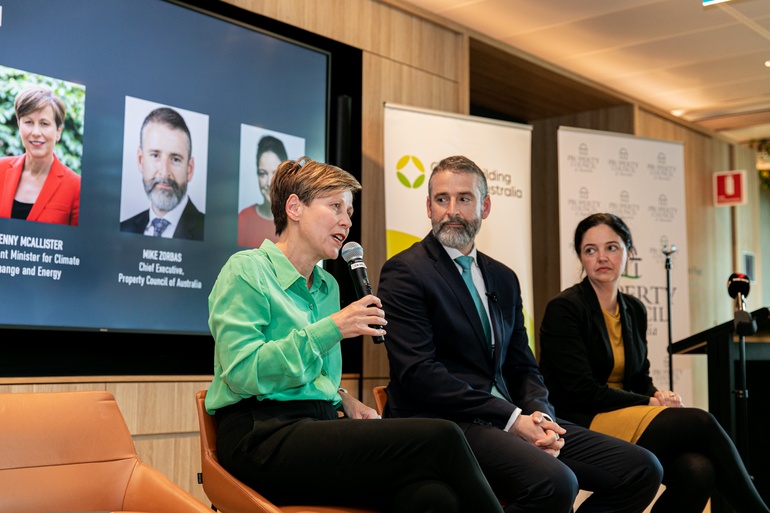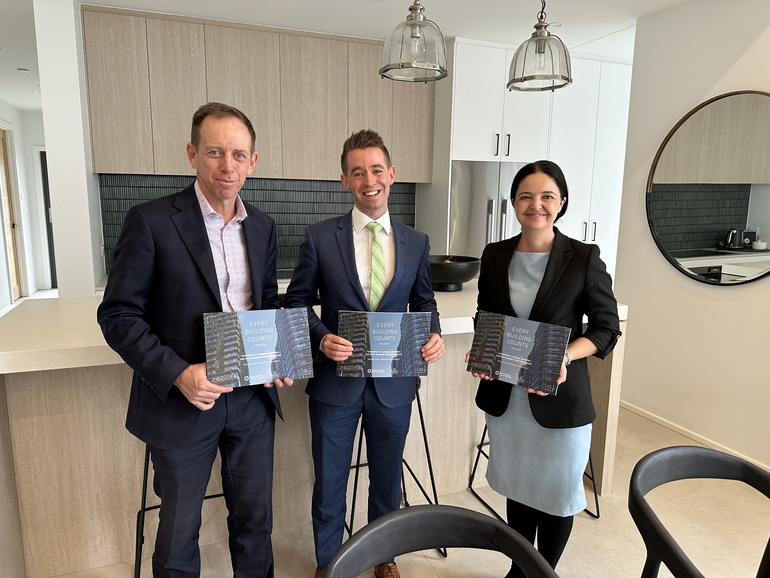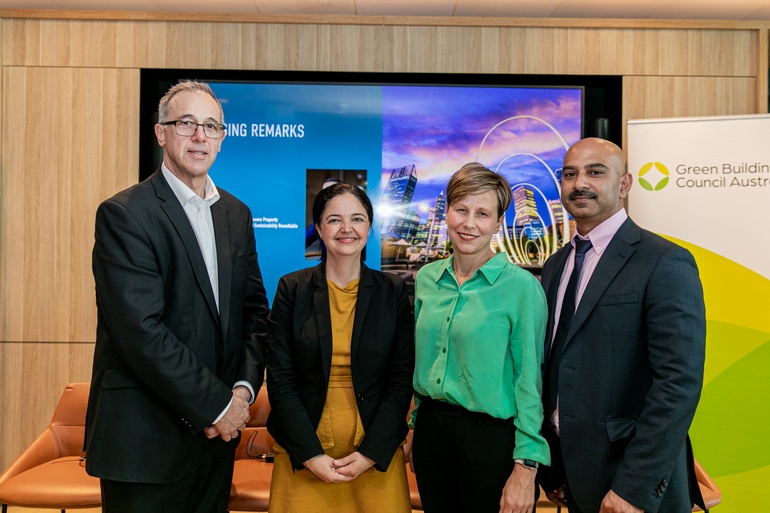Making every building count in 2023 and beyond
14 Dec 2023
When we launched the first version of Every Building Counts with the Property Council in October 2019 it was a landmark plan for decarbonising our nation’s built environment, outlining 75 recommendations for all three tiers of government. It was released at a time when Australia had signed the Paris Agreement but didn’t have a clear emissions reduction target or a pathway to net zero by 2050. We now do, and that’s crucial because buildings account for over 50% of electricity use in Australia and almost a quarter of its emissions. We checked in with Andrew Fischer, our Head of Policy and Research for an end of year update on Every Building Counts.
Government policies and programs can provide certainty to industry and lead the transition to zero-carbon-ready homes and buildings. At GBCA we work closely with all three tiers of government to support the design and implementation of policies and programs that do just this and in 2023 we saw more come to fruition than ever before.
From electrifying a coastal town of Western Australia, to a comprehensive plan to retrofit Melbourne's existing commercial buildings, and Green Star requirements for federal government-owned buildings, 2023 will go down in history as the year governments heeded our calls to make every building count. We look forward to seeing this momentum continue and expand in 2024.
Federal government showing the way
Every Building Counts 2023 was launched on 27 April by Senator the Hon Jenny McAllister, Assistant Minister for Climate Change and Energy. Released by GBCA and Property Council of Australia at an event in Sydney, Every Building Count’s federal policy platform provides 39 policy recommendations over eight themes which provide a roadmap for the federal government towards a greener, healthier, more equitable built environment.
- March – the Albanese Government introduces amendments to the Safeguard Mechanism as well as introducing a new National Reconstruction Fund help Australia achieve our commitments under the Paris Agreement. The National Reconstruction Fund will boost investment in renewables and low emission technologies to support Australian industries decarbonise, while amendments to the Safeguard Mechanism adjust declining baselines for high-emitting facilities and create an emissions trading system to incentivise change.

- May - the Budget allocates billions to new measures that will supercharge the net zero transition, including $1.3 billion to establish the Household Energy Upgrades Fund, $4 billion to further the government’s ambition for Australia to be a “renewable energy superpower” and a national approach to sustainable urban development, backed by $687.4 million over six years. Learn more about the Budget’s measures here.
- June – the government announces Australia’s first National Climate Risk Assessment to inform the National Adaptation Plan. Backed by $27.4 million in funding over 2 years, this commitment will bring together experts, scientists, communities, businesses, and First Nations people to develop a national approach to climate adaptation for all levels of government, the private sector, and NGOs.
- August - the Net Zero 2050 plan launches and includes a commitment to develop a decarbonisation plan for the built environment alongside the energy, industry, agriculture, transport and resources sectors.
- November – GBCA welcomes the Net Zero in Government Operations Strategy that will help it achieve a net zero Australian public service by 2030. The ambitious plan includes the use of Green Star, NABERS, and Infrastructure Sustainability ratings, as well as electrification requirements to drive down emissions in buildings.
Local government helping to solve global problems
In October, we joined Property Council of Australia in Melbourne to launch Every Building Counts - For local governments. Local governments around Australia have been demonstrating leadership on climate change action for many years and this report supports them with 19 recommendations to accelerate the transition sustainable infrastructure, towns and communities.
- September - Zero Carbon Merri-bek is awarded at the Cities Power Partnership Climate Awards for its ‘all in one’ service including financial support for low-income homeowners to install solar panels or improve the thermal comfort of their homes whilst lowering energy bills and reducing carbon emissions
- October - City of Melbourne launches Retrofit Melbourne. Developed in partnership with industry, this is the council’s comprehensive framework to enable mid-tier commercial buildings transition to be zero carbon ready
- October - the Better Building Partnership joined City of Sydney Council to share a new guide to complement GBCA’s A practical guide to electrification – for existing buildings. The new document, Electrification resource pack – for Asset Managers and Facility Managers will help asset managers and facility managers develop and implement plans to remove natural gas from buildings.

- October - Woollahra proposes an amendment to transition households away from gas by introducing new controls aimed at improving indoor air quality, joining several other local councils in NSW working on similar proposed amendments
- December - Adelaide City Council began discussing its goal to make all new CBD homes and buildings gas-free from 2025. The council’s draft integrated climate strategy outlines a plan to reach net zero emissions by 2035.
State and territories realising their potential to reach zero carbon
This week we launched Every Building Counts - for state and territory governments at an event in Canberra. Outlining a series of policy recommendations centred on how our states and territories can support property to contribute to Australia’s decarbonisation goals, the report has been released followings a series of decarbonisation commitments and initiatives across Australia throughout 2023.
- March - the town of Esperance in WA successfully transitions to electric power, paving the way for other towns to follow. It's a transition the government expects will help reduce energy bills and carbon emissions and was the first electrification of this kind in Australia.
- April - ACT government launches an award winning tool that helps Canberra households create their own energy transition plan to switch off gas.
- May - the Western Australian Climate Policy sets out the government’s plan for climate-resilient communities and a prosperous low-carbon future.
- August – the Victorian government announces that from 1 January 2024, all new homes and residential subdivisions – including new public and social housing delivered by Homes Victoria - will be all-electric. All new public buildings that haven’t yet reached design stage must also be all-electric, including new schools, hospitals, police stations and other government-owned buildings.
- September - Victorian government releases a $10 million Residential Electrification Grants program allowing companies providing installations to more than 50 new or existing homes to apply for rebates. The program aims to accelerate electrification of homes at scale and builds on the $1.3 billion Solar Homes Program.
- October - NSW was the first state to implement agreed updates in the National Construction Code 2022 via introduction of the Sustainable Buildings SEPP and updates to the Building Sustainability Index (BASIX). These enhanced sustainability standards will improve energy efficiency and accessibility for most new residential buildings across NSW, and apartment buildings up to five storeys.
- October – eligible Victorian households will have access to new $8,800 interest free battery loans to help households reduce the upfront costs of installing batteries, maximise output from solar panels and save thousands on energy bills, while also helping Victoria to reach net zero emissions by 2045.
- October – The Queensland government proposes a roadmap for reducing emissions in government infrastructure. The roadmap will support the implementation of the 2022 State Infrastructure Strategy 2022 which prioritises enhanced sustainability and resilience and the Queensland government’s commitment to achieving certification for Brisbane 2032 Olympics infrastructure with the Green Star and Infrastructure Sustainability rating tools.
- October – Tasmanian Government released the Mac Point Draft Precinct Plan which requires Green Star Communities certification through the pre, during and post-development phases of the site’s renewal.
- November – the Tasmanian Future Gas Strategy launches, outlining the government’s vision for the future of gas in Tasmania. The strategy aims to help gas users and suppliers make informed choices and investment decisions during a time of uncertainty and rapid transition for the industry.
- November – NSW Parliament passes the Climate Change (Net Zero Future) Bill 2023. The guiding principles in the Bill include an Australian first, the recognition of a right to a sustainable environment.
- November - WA Government introduced the Climate Change Bill 2023 to Parliament. The Bill aims to establish a framework for emissions reductions and climate resilience in Western Australia and formalise WA Government's net zero emissions by 2050 target.
- December – ACT government’s Climate Change and Greenhouse Gas Reduction (Natural Gas Transition) Amendment Bill came into force placing a ban on gas connections in all new homes and businesses built in the territory. Already powered by 100% renewables, the gas ban places ACT at the forefront of electrification in Australia.
- December - the Sectoral emissions reduction strategy for Western Australia is released, laying out pathways and priority actions for WA's transition to net zero emissions. The strategy builds on the state's introduction of climate change legislation and the release of its first climate adaptation strategy. It prioritises electrification, energy efficiency and circular outcomes for buildings and commits to work with the Australian Government on developing a national framework for disclosure of residential energy-efficiency information.

- December – The Victorian government shares an update on its Gas Substitution Roadmap, reasserting that ‘rapid electrification in a key priority’. The update sees induction cooktops added to the Victorian Energy Upgrades Program from mid-2024, and commits to consultation on expanding the January 2024 ban on new gas connections to include all new residential dwellings and some commercial buildings, increased performance standards in rental homes, and the costs and benefits of requiring existing gas appliances in homes and relevant commercial buildings be replaced with electric appliances when the current appliance reaches end-of-life.
Buildings, homes and communities hold huge potential to help our nation respond to a changing climate. Green Building Council of Australia commends all levels of government for recognising and acting on this potential in 2023 and we look forward to continuing this work in 2024.